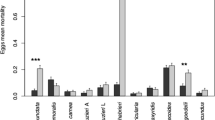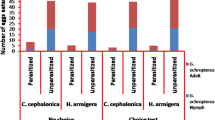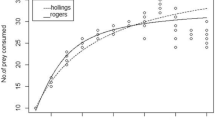Abstract
The mealybug destroyer Cryptolaemus montrouzieri has been introduced in many countries for biological control of mealybug species, recently the ladybeetle was tested on the biocontrol efficiency of Dactylopius opuntiae in many countries such as Brazil, Israel, and Morocco. Also, a total of thirteen species belonging to three orders and three families of local natural enemies associated to D. opuntiae were collected from Zemamra locality, and Gharbia locality in the Sidi Bennour region (120 km north-west of Marrakech), Morocco, and identified. A laboratory examination of C. montrouzieri eggs predation by eleven Morocco local generalist predators adults Hyperaspis campestris, Scymnus interruptus. Scymnus loewii, Nephus redtenbacheri, Scymnus latemaculatus, Scymnus guttulatus, Exochomus nigripennis, Coccinella septempunctata, Hippodamia convergens, Chilocorus bipustulatus, and Chilocorus politus showed that C. septempunctata had the highest predation on C. montrouzieri eggs (51 to 99% after 24 h) when provided with, or without, an alternative food supply (D. opuntiae first and second instars nymphs and Aphis fabae larvae). The addition of an alternative food source reduced egg predation by local polyphagous ladybeetles adults tested. These findings should be considered during biocontrol program on D. opuntiae and mass-rearing production.
Similar content being viewed by others
References
Aldama-Aguilera C, Llanderal-Cázares C (2003) Cochineal: comparison of production methods in cut cladodes. Agrociencia 37:11–19
Agarwala BK, Yasuda H (2001) Overlapping oviposition and chemical defense of eggs in two co-occurring species of ladybird predators of aphids. J Ethol 19:47–53
Barbosa PRR, Oliveira MD, Giorgi JA, Oliveira JEM, Torres JB (2014) Suitability of two prey species for development, reproduction, and survival of Tenuisvalvae notata (Coleoptera: Coccinellidae). Ann Entomol Soc Am 107:1102–1109
Bouharroud R, Sbaghi M, Boujghagh M, El Bouhssini M (2018) Biological control of the prickly pear cochineal Dactylopius opuntiae Cockerell (Hemiptera: Dactylopiidae). EPPO Bulletin 48:300–306
Bouharroud R, El Aalaoui M, Boujghagh M, Hilali L, El Bouhssini M, Sbaghi M (2019) New record and predatory activity of Hyperaspis campestris (Herbst 1783) (Coleoptera: Coccinellidae) on Dactylopius opuntiae (Hemiptera: Dactylopiidae) in Morocco. Entomol News 128(2):156–161
Canepari C, Fursch H, Kreissl E (1985) Die Hyperaspis-Arten von Mittel-,West-und Südeuropa. Systematik und Verbreitung. G Ital Entomol 2:223–252
Carver RH, Nash JG (2011). Doing data analysis with SPSS: version 18.0. Cengage learning
Chacón JM, Landis DA, Heimpel GE (2008) Potential for biotic interference of a classical biological control agent of the soybean aphid. Biol Control 46:216–225
Chong JH, Oetting RD (2006) Functional response and progeny production of the Madeira mealybug parasitoid, Anagyrus sp. nov. nr. Sinope: the effects of host and parasitoid densities. Biol Control 39:320–328
Clausen CP (1978). Introduced parasites and predators of arthropod and weeds: a world review. (Ed. Clausen, C. P.), agriculture handbook no. 480, USDA Agricultural Research Service, Washington, D. C., 545 pp
Cottrell TE, Yeargan KV (1998) Influence of a native weed, Acalypha ostryaefolia (Euphorbiaceae), on Coleomegilla maculate (Coleoptera: Coccinellidae) population density, predation, and cannibalism in sweet corn. Environ Entomol 27:1375–1385
Cottrell TE (2005) Predation and cannibalism of lady beetle eggs by adult lady beetles. Biol Control 34(2):159–164
El Aalaoui M, Bouharroud R, Sbaghi M, El Bouhssini M, Hilali L (2019a) Predatory potential of eleven native Moroccan adult ladybird species on different stages of Dactylopius opuntiae (Cockerell) (Hemiptera: Dactylopiidae). EPPO Bulletin 49(2):374–379
El Aalaoui M, Bouharroud R, Sbaghi M, El Bouhssini M, Hilali L, Dari K (2019b) First study of the biology of Cryptolaemus montrouzieri and its potential to feed on the mealybug Dactylopius opuntiae (Hemiptera: Dactylopiidae) under laboratory conditions in Morocco. Arch Phytopathol Plant Protect 52:1112–1124
El Aalaoui M, Bouharroud R, Sbaghi M, El Bouhssini M, Hilali L, Dari K (2019c) Comparative toxicity of different chemical and biological insecticides against the scale insect Dactylopius opuntiae and their side effects on the predator Cryptolaemus montrouzieri. Arch Phytopathol Plant Protect 52:155–169
Felix SANDRA, Soares AO (2004) Intraguild predation between the aphidophagous ladybird beetles Harmonia axyridis and Coccinella undecimpunctata (Coleoptera: Coccinellidae): the role of body weight. Eur J Entomol 101:237–242
Fox TB, Landis DA, Cardoso FF, Difonzo CD (2004) Predators suppress Aphis glycines Matsumura population growth in soybean. Environ Entomol 33:608–618
Gillespie DR, Quiring DJM (1992) Competition between Orius tristicolor (white) (Hemiptera: Anthocoridae) and Amblyseius cucumeris (Oudemans) (Acari: Phytoseiidae) feeding on Frankliniella occidentalis (Pergande) (Thysanoptera: Thripidae). Can Entomol 124:1123–1128
Kratina P, Vos M, Bateman A, Anholt BR (2007) Species diversity modulates predation. Ecology 88:1917–1923
Kratina P, Vos M, Bateman A, Anholt BR (2009) Functional responses modified by predator density. Oecologia 159:425–433
Koch RL, Hutchinson WD, Venette RC, Heimpel GE (2003) Susceptibility of immature monarch butterfly, Danaus plexippus (Lepidoptera: Nymphalidae) to predation by Harmonia axyridis (Coleoptera: Coccinellidae). Biol Control 28:265–270
Labbé RM, Cloutier C, Brodeur J (2006) Prey selection by Dicyphus hesperus of infected or parasitized greenhouse whitefly. Biocontrol Sci Tech 16:485–494
Lucas E, Coderre D, Brodeur J (1998) Intraguild predation among aphid predators: characterization and influence of extraguild prey density. Ecology 79:1084–1092
Lucas E (2005) Intraguild predation among aphidophagous predators. Eur J Entomol 102:351–364
Martinou AF, Raymond B, Milonas PG, Wright DJ (2010) Impact of intraguild predation on parasitoid foraging behaviour. Ecol Entomol 35:183–189
Martinou AF, Stavrinides MC (2015) Effects of sublethal concentrations of insecticides on the functional response of two Mirid generalist predators. PLoS One 10(12):e0144413
Musser FR, Shelton AM (2003) Factors affecting the temporal and within plant distribution of coccinellids in corn and their impact on potential intra-guild predation. Environ Entomol 32:575–583
Noia M, Borges I, Soares AO (2008) Intraguild predation between the aphidophagous ladybird beetles Harmonia axyridis and Coccinella undecimpunctata (Coleoptera: Coccinellidae): the role of intra and extraguild prey densities. Biol Control 46(2):140–146
Polis GA, Myers CA, Holt RD (1989) The ecology and evolution of intraguild predation: potential competitors that eat each other. Annu Rev Ecol Syst 20:297–330
Polis GA, Holt RD (1992) Intraguild predation: the dynamics of complex trophic interactions. Trends Ecol E vol 7:151–154
Protasov A, Mendel Z, Spodek M, Carvalho CJ (2017) Management of the Opuntia cochineal scale insect, Dactylopius opuntiae (Cockerell) in Israel. Alon Hanotea 71:48–51
Rosenheim JA (1998) Higher-order predators and the regulation of insect herbivore populations. Annu Rev Entomol 43:421–447
Sanches NF, Carvalho RS (2010). Procedimentos para manejo da criação e multiplicação do predador exótico Cryptolaemus montrouzieri. Cruz das Almas: Embrapa Mandioca e Fruticultura 5 p
Sato S, Dixon AF, Yasuda H (2003) Effect of emigration on cannibalism and intraguild predation in aphidophagous ladybirds. Ecol Entomol 28(5):628–633
Sato S, Jimbo R, Yasuda H, Dixon AF (2008) Cost of being an intraguild predator in predatory ladybirds. Appl Entomol Zool 43(1):143–147
Sengonca C, Frings B (1985) Interference and competitive behaviour of the aphid predators, Chrysoperla carnea and Coccinella septempunctata in the laboratory. Entomophaga 30:245–251
Solangi GS, Lohar MK, Abro GH, Buriro AS (2012) Biology and release of exotic predator Cryptolaemus montrouzieri Mulsant on mealybug Phenacoccus solenopsis Tinsley at Tandojam. Sarhad J Agric 28:429–435
Stubbs AE, Falk JS (1996). British hover flies: an illustrated identification guide. British Entomological and Natural History Society. 253 pp
Symondson WOC (2002) Molecular identification of prey in predator diets. Mol Ecol 11:627–641
Vanegas-Rico JM, Lomeli-Flores JR, Rodríguez-Leyva E, Mora-Aguilera G, Valdez JM (2010) Natural enemies of Dactylopius opuntiae (Cockerell) on Opuntia ficus-indica (L.) miller in Central Mexico. Acta Zool Mex (ns) 26:415–433
Van Lenteren JC, Bale J, Bigler F, Hokkanen HMT, Loomans AJM (2006) Assession risks of releasing exotic biological control agents of arthropod pests. Annu Rev Entomol 51:609–643
Yasuda H, Shinya K (1997) Cannibalism and interspecific predation in two predatory ladybirds in relation to prey abundance in the field. Entomophaga 42:153–163
Yasuda H, Kikuchi T, Kindlmann P, Sato S (2001) Relationships between attack and escape rates, cannibalism, and intraguild predation in larvae of two predatory ladybirds. J Insect Behav 14:373–384
Yasuda H, Evans EW, Kajita Y, Urakawa K, Takizawa T (2004) Asymmetric larval interactions between introduced and indigenous ladybirds in North America. Oecologia 141:722–731
Funding
The research of this study was carried out as part of the collaborative program between the National Institute of Agronomic Research (INRA) and the International Center for Agricultural Research in the Dry Areas (ICARDA) in Morocco.
Author information
Authors and Affiliations
Corresponding author
Ethics declarations
Conflict of interest
Author A declares that he has no conflict of interest.
Ethical approval
This article does not contain any studies with human participants or animals performed by any of the authors.
Additional information
Publisher’s note
Springer Nature remains neutral with regard to jurisdictional claims in published maps and institutional affiliations.
Rights and permissions
About this article
Cite this article
El Aalaoui, M., Sbaghi, M., Bouharroud, R. et al. Hyperpredation of local adults ladybirds on the eggs of Cryptolaemus montrouzieri a potential predator of carmine cactus cochineal Dactylopius opuntiae in Morocco. Int J Trop Insect Sci 41, 1011–1016 (2021). https://doi.org/10.1007/s42690-020-00282-w
Received:
Accepted:
Published:
Issue Date:
DOI: https://doi.org/10.1007/s42690-020-00282-w




